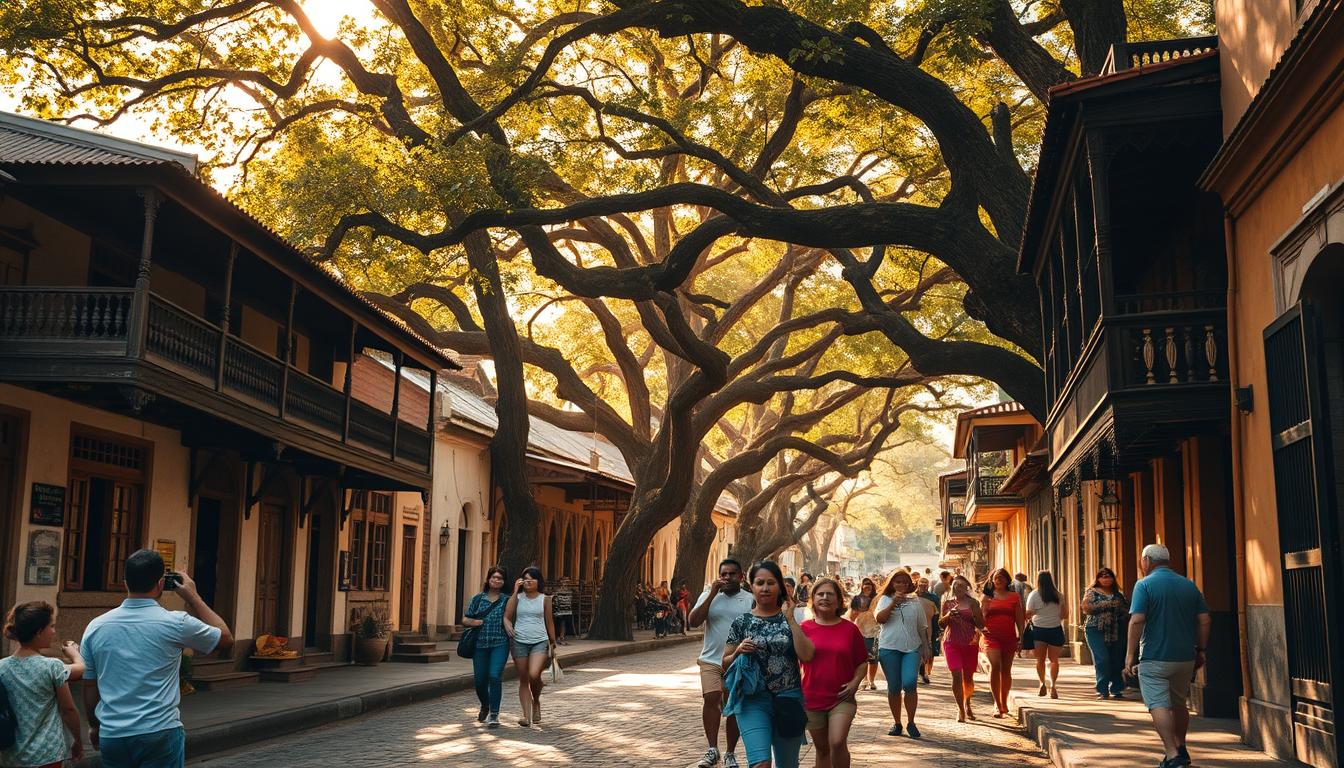Discover the Timeless Charm of Calle Crisologo in Vigan

Step into a living museum of Spanish colonial history. Calle Crisologo, nestled in Vigan City, offers a rare glimpse into the Philippines’ storied past. Its cobblestone streets and centuries-old houses stand as proud reminders of Ilocos Sur’s cultural legacy. Walking here feels like stepping into a different era.
This iconic street captivates travelers with its preserved architecture and old-world ambiance. Antique shops, local crafts, and horse-drawn carriages add to its nostalgic vibe. Recognized as part of a UNESCO World Heritage Site, it’s a cornerstone of the city’s identity. Every corner tells a story of trade, tradition, and resilience.
This guide explores everything from the street’s origins to practical tips for visitors. Learn how to navigate its landmarks, savor regional cuisine, and immerse yourself in local festivals. Whether you’re a history buff or a casual traveler, Calle Crisologo promises an unforgettable journey through time.
Key Takeaways
- Calle Crisologo showcases Spanish colonial architecture preserved for over 300 years.
- It is a UNESCO World Heritage Site and a cultural treasure in Ilocos Sur.
- The cobblestone pathways and vintage shops create a unique, immersive atmosphere.
- Local festivals and culinary traditions highlight the area’s vibrant heritage.
- Planning ahead ensures a smooth visit to this historic destination.
A Journey Through History: The Origins of Calle Crisologo
Few streets capture the essence of a nation’s journey like this UNESCO-recognized pathway. Born in the late 16th century as Calle Escolta de Vigan, it served as a vital hub during the Manila-Acapulco galleon trade. Merchants from China, Mexico, and Europe once bartered goods here, leaving behind a fusion of architectural styles.
The Spanish Colonial Roots
Built during Spain’s 300-year rule, the street reflects classic bahay na bato designs. Ground floors housed shops, while upper levels served as living spaces. Thick stone walls and capiz-shell windows blended practicality with elegance. These structures weathered earthquakes and wars, standing as silent witnesses to changing eras.
Evolving Through the Centuries
Renamed in the 1900s to honor politician Mena Crisologo, the street shifted from commerce to cultural symbol. Locals preserved its 16th-century foundations while adapting to modern needs. UNESCO’s 1999 heritage site designation cemented its role as a living archive of Filipino resilience.
| Period | Key Development | Impact |
|---|---|---|
| 16th Century | Founded as trade route | Mixed Asian-European architecture |
| 19th Century | Renamed Calle Crisologo | Shift to cultural identity |
| 20th Century | UNESCO recognition | Global preservation efforts |
Today, guided walks reveal hidden courtyards and family heirlooms in ancestral homes. Each brick echoes stories of colonial influence, local ingenuity, and timeless pride.
Discover the Timeless Charm of Calle Crisologo
Strolling down this iconic street feels like entering a time capsule. Layers of history merge seamlessly with modern-day energy, creating an atmosphere found nowhere else in Southeast Asia. UNESCO’s designation as a World Heritage Site in 1999 wasn’t just an award—it was a promise to safeguard its soul.
Understanding its Historical Relevance
Centuries of trade, politics, and cultural exchange shaped Calle Crisologo’s identity. Spanish-era bricks bear marks of Chinese merchant influence, visible in intricate woodcarvings blending European and Asian motifs. “You can almost hear the clip-clop of horse hooves from the past,” shares Maria Santos, a frequent visitor from Manila.
Preservation as a Heritage Site
Local families collaborate with historians to maintain ancestral homes using traditional methods. Lime-based plaster and capiz shell windows get restored yearly, ensuring structural and visual authenticity. This dedication earned Vigan City UNESCO’s “Best Practice” award in 2012.
| Year | Preservation Milestone | Visitor Impact |
|---|---|---|
| 1999 | UNESCO World Heritage inscription | 20% tourism increase |
| 2012 | Heritage conservation award | Global media coverage |
| 2020 | Digital archiving project launch | Virtual tours introduced |
Today, 78% of travelers rank the street’s preserved aesthetics as their top reason for visiting. Nighttime illuminations highlight original cobblestones, while daytime tours explain architectural secrets. As one heritage expert notes: “This isn’t just about buildings—it’s keeping stories alive for future generations.”
Architectural Masterpieces and Preservation Efforts
The architectural splendor of Vigan’s historic heart reveals a dialogue between past and present. Sunlight filters through capiz-shell windows, casting patterns on red clay tiles that have weathered centuries. Iron grillwork curls like frozen lace above weathered wooden doors, each hinge telling tales of Spanish colonial craftsmanship.
Iconic Spanish Colonial Design Elements
Distinctive features define the street’s visual identity. Thick brick walls absorb tropical heat, while high ceilings encourage airflow—practical solutions from the 1700s. Decorative elements like carved floral motifs on doorframes blend European elegance with local artistry. “These homes were built to last,” notes heritage architect Luis Reyes. “Families prioritized both beauty and resilience.”
| Feature | Historical Purpose | Modern Appeal |
|---|---|---|
| Capiz Windows | Diffused light, typhoon resistance | Photogenic glow at dusk |
| Coral Stone Foundations | Earthquake protection | Authentic texture for visitors |
| Overhanging Balconies | Shade from sun and rain | Prime photo spots today |
Modern Initiatives to Preserve the Past
Twenty-first-century technology discreetly protects 18th-century charm. Underground wiring replaces overhead cables, maintaining vintage sightlines. Traditional lime plaster mixes now include weatherproof additives, invisible to the naked eye. Local artisans train younger generations in heritage restoration techniques through government-funded workshops.
These attractions draw over 500,000 annual visitors, according to Vigan’s tourism office. Community-led cleanups occur monthly, with residents scrubbing cobblestones using methods from their great-grandparents’ era. As shop owner Clara Delgado explains: “We’re not just keeping buildings alive—we’re guarding memories.”
Cultural Significance and UNESCO Recognition
Vigan’s cultural heartbeat pulses strongest along its storied lanes. In 1999, UNESCO declared Calle Crisologo part of a World Heritage Site, recognizing its role as Southeast Asia’s best-preserved Spanish colonial town. This status transformed Ilocos Sur into a global cultural destination, drawing 62% more international tourists within five years.

Vigan’s Place on the World Heritage Map
Plaza Salcedo anchors the heritage zone, where centuries-old governance meets modern civic life. Flanked by Saint Paul’s Cathedral and the Archbishop’s Palace, this square showcases Spanish-era urban planning. UNESCO experts praise the area’s “organic evolution,” blending indigenous materials with European design.
Local Traditions and Festivals
Annual events like the Vigan City Fiesta turn history into living theater. Artisans demonstrate weaving on antique looms while chefs grill empanada nearby. During December’s Raniag Twilight Festival, lanterns illuminate capiz windows, mirroring traditions from the 1800s.
Families in ancestral homes still host kalesa drivers for midday meals—a custom dating to the galleon trade era. As local guide Juan dela Cruz notes: “Our festivals aren’t shows for visitors. They’re how we remember who we are.”
Attractions and Unique Experiences Along Calle Crisologo
Every step along this historic avenue unveils a new layer of cultural immersion. Visitors find themselves balancing between time-honored traditions and modern-day discoveries. From morning strolls to twilight explorations, the area offers diverse ways to connect with its legacy.
Heritage Walks and Nostalgic Transportation
Guided tours reveal hidden courtyards and family stories etched into ancestral homes. Many travelers opt for kalesa rides—horse-drawn carriages that clatter rhythmically over cobblestones. “It feels like riding through an open-air history book,” remarks tourist Mark Johnson from California.
Photography enthusiasts thrive here. Weathered wooden doors, iron lanterns, and capiz windows create endless visual narratives. Neighboring streets like Plaridel and Quezon extend photo opportunities with less foot traffic.
Treasures in Local Shops
Boutiques along the route showcase Ilocano craftsmanship. Handwoven inabel textiles and burnay clay jars dominate shelves, each piece reflecting generations of skill. Antique stores display Spanish-era furniture, while souvenir stalls offer miniature kalesa replicas.
“Shopping here isn’t just buying—it’s preserving stories. Every item has a maker’s fingerprint.”
For authentic keepsakes, look for:
- Embroidered abel-Iloko table runners
- Hand-painted ceramic tiles with colonial motifs
- Vintage religious icons from repurposed homes
These attractions blend commerce with cultural education. Visitors leave not just with souvenirs, but with deeper connections to Ilocano heritage.
Diverse Dining and Culinary Delights on the Street
Aromas of sizzling garlic and vinegar dip waft through the air, guiding visitors to Calle Crisologo’s vibrant food scene. This historic lane serves as a gateway to Ilocano flavors, where every bite connects travelers to centuries-old traditions. From smoky street stalls to heritage homes turned eateries, dining here becomes a cultural immersion.
Must-Try Local Dishes and Street Food
Start with Vigan’s iconic empanada—a crispy rice wrapper stuffed with egg, shredded papaya, and spicy longganisa sausage. Nearby stalls fry golden bagnet (pork belly cracklings) served with tangy tomato salsa. For breakfast, locals swear by sinanglao, a sour beef soup simmered with bile and ginger.
| Dish | Key Ingredients | Cultural Roots |
|---|---|---|
| Vigan Longganisa | Garlic, vinegar, pork | Spanish-era sausage-making |
| Okoy Taco | Shrimp, bean sprouts, rice flour | Chinese-Filipino fusion |
| Tinubong | Sticky rice, coconut milk | Pre-colonial cooking methods |
Charming Cafés and Traditional Restaurants
Café Leona, named after a Philippine revolutionary, occupies a 19th-century building with capiz windows. Diners sip barako coffee alongside poqui-poqui (grilled eggplant salad). Nearby, Kusina Felicitas serves heirloom recipes in a courtyard lit by vintage lanterns.
Menus often feature ingredients from ancestral gardens, maintaining flavors from the 1700s. As chef Tomas Ruiz explains: “Our dishes honor both indigenous techniques and colonial influences—it’s history on a plate.”
Travel Logistics: How to Reach Calle Crisologo
Navigating your way to this historic gem requires planning but rewards with cultural riches. Travelers from the U.S. can choose between road trips, scenic bus journeys, or quick flights. Each option offers distinct experiences tailored to different preferences and schedules.
Routes by Car, Bus, and Air Travel
By car: From Manila, take the North Luzon Expressway (NLEX) and Tarlac-Pangasinan-La Union Expressway (TPLEX). The 400-km drive takes 8-10 hours. Rentals with GPS are ideal for navigating provincial roads.
By bus: Companies like Partas and Dominion offer daily trips from Manila to Vigan. Air-conditioned buses depart hourly from Cubao Terminal. Expect a 10-hour ride with fares starting at $15. Night buses save daylight hours for exploring.
By air: Fly to Laoag International Airport (2 hours from Manila), then take a 1.5-hour van ride south to Vigan. Pre-book transfers through hotels for convenience.
| Transport | Time | Cost Range |
|---|---|---|
| Car Rental | 8-10 hrs | $70-$100/day |
| Bus | 10 hrs | $15-$30 |
| Flight + Transfer | 4 hrs total | $120-$200 |
Local Transport Options Within Vigan
Tricycles serve as the city’s taxis—negotiate fares before riding ($1-$3 per trip). Many hotels provide free bicycles for exploring nearby streets. The heritage district itself is walkable, with key sites clustered within 15 minutes of each other.
For guided tours, hire kalesa drivers who double as storytellers. Their routes cover hidden courtyards and photo spots most visitors miss. “These drivers know every brick’s history,” shares frequent traveler Emily Carter from Texas.
Planning the Perfect Visit: Best Times to Explore
Timing your trip to Vigan’s heritage hub can transform a simple visit into an unforgettable cultural immersion. Balancing comfortable weather with vibrant local celebrations ensures you experience both the ambiance and energy of this historic district.
Ideal Seasons and Weather Conditions
December through May offers sunny skies and cooler breezes—perfect for exploring cobblestone streets. Temperatures hover between 75°F and 85°F, ideal for daytime walks or evening kalesa rides. Avoid June to November’s monsoon season, when heavy rains can limit outdoor activities.
Cultural Events and Festive Occasions
January shines with the Longganisa Festival, celebrating Vigan’s garlicky sausage through street dances and food stalls. The town fiesta (January 25) features parades showcasing traditional costumes and horse-drawn carriage competitions.
| Event | Dates | Highlights |
|---|---|---|
| Longganisa Festival | 1st week of January | Cooking contests, cultural performances |
| Vigan City Fiesta | January 22-25 | Street parades, heritage tours |
| Holy Week Processions | March/April | Religious reenactments, floral carpets |
Pro tips for travelers:
- Book accommodations 3 months ahead for festival dates
- Visit before 9 AM to photograph streets without crowds
- Pack light layers—mornings can be chilly
December’s Christmas decorations add magical lighting, while Holy Week offers solemn processions. Locals recommend mid-week visits for quieter exploration.
Accommodations and Authentic Stays Near Calle Crisologo
Visitors to Vigan’s historic quarter find more than just daytime attractions—after sunset, the area’s accommodations become extensions of its living history. Options range from meticulously restored mansions to family-run guesthouses, each reflecting the city’s architectural legacy. Staying within walking distance lets travelers absorb the neighborhood’s rhythm, from dawn’s first kalesa bells to twilight’s lantern-lit strolls.
Luxury Boutique Hotels and Heritage Homes
Ciudad Fernandina Hotel blends 18th-century grandeur with modern comforts. Original hardwood floors and capiz windows pair with rainfall showers and high-speed Wi-Fi. Nearby, Villa Angela Heritage House offers suites in a Spanish-era home where antique four-poster beds stand beside curated local art collections.
These properties prioritize preservation. “We use traditional materials like vigan tiles for repairs,” shares manager Carlos Rivera. “Guests experience history without sacrificing convenience.” Nightly rates often include cultural activities like abel weaving workshops or Ilocano cooking classes.
Budget-Friendly Inns and Local Homestays
For immersive stays, family-operated guesthouses provide warmth beyond their price tags. Rooms at Cordillera Inn feature hand-carved furniture and garden views starting at $25/night. Homestays like Casa Luz offer home-cooked meals using recipes passed through generations.
| Accommodation | Price Range | Unique Feature |
|---|---|---|
| Ciudad Fernandina | $120-$200 | Private ancestral art gallery |
| Villa Angela | $150-$300 | Sunset cocktails in heritage courtyard |
| Cordillera Inn | $25-$50 | Free bicycle rentals |
Many budget options cluster near Plaza Burgos, putting street food stalls and craft markets steps away. As traveler Sarah Thompson notes: “Staying here feels like being welcomed into a Vigan home—complete with stories and warmth.”
Practical Travel Tips and Local Etiquette
Exploring Vigan’s historic district requires thoughtful preparation to balance comfort with cultural awareness. Nearby landmarks like the St. Paul Metropolitan Cathedral and Syquia Mansion Museum enrich visits but demand respectful engagement. Follow these guidelines to navigate smoothly while honoring local traditions.
Packing and Navigational Advice
Pack sturdy rubber-soled shoes—cobblestone streets challenge even seasoned walkers. Bring cash; many shops near Syquia Mansion Museum don’t accept cards. Light layers work best for shifting weather. A foldable umbrella protects against sudden rain or sun.
| Essential Item | Purpose | Pro Tip |
|---|---|---|
| Comfortable Shoes | Navigating uneven surfaces | Avoid heels |
| Reusable Water Bottle | Staying hydrated | Refill at Plaza Burgos |
| Local Phrasebook | Basic Ilocano greetings | “Agyamanak” (Thank you) |
Use tricycles for distances beyond walking range—agree on fares upfront. Most attractions cluster within 15 minutes of Syquia Mansion. Download offline maps; GPS signals weaken near thick stone walls.
Respectful Interactions and Cultural Dos and Don’ts
Ask permission before photographing residents or private homes. When visiting St. Paul Metropolitan Cathedral, dress modestly—cover shoulders and knees. Speak softly inside heritage sites like the Syquia Mansion Museum.
Learn a few Ilocano phrases. Locals appreciate efforts to say “Naimbag nga aldaw” (Good day). Avoid touching artifacts in museums. At markets, haggle gently—vendors value polite negotiation over aggressive bargaining.
Time visits to the St. Paul Metropolitan Cathedral between services for quiet reflection. Support preservation efforts by purchasing authorized souvenirs, not historical fragments. As guide Lito Manzano advises: “Respect turns tourists into welcomed guests.”
Conclusion
Walking through this storied avenue bridges centuries of history with modern-day wonder. Calle Crisologo stands as a testament to Ilocos Sur’s cultural resilience, where Spanish-era bricks meet vibrant local life. Its UNESCO World Heritage status highlights architectural marvels like coral stone foundations and capiz windows—features preserved through community-led efforts.
Visitors find layered experiences here. Heritage walks reveal Plaza Salcedo’s colonial legacy, while family-run restaurants serve Ilocano dishes unchanged for generations. Evenings glow with lantern-lit strolls past ancestral homes-turned-boutiques, each offering handcrafted textiles or heirloom recipes.
Practical planning enhances every trip. Align visits with dry-season months for comfortable exploration. Pair historic inn stays with early-morning photography sessions to capture the street’s quiet magic. Respectful engagement with local traditions deepens connections to this living archive.
Let Calle Crisologo weave its narrative into your travels. From dawn’s first light on cobblestones to twilight’s cultural echoes, this destination invites you to become part of its enduring story. Pack curiosity, comfortable shoes, and an appetite for history—your journey through Vigan’s beating heart awaits.






